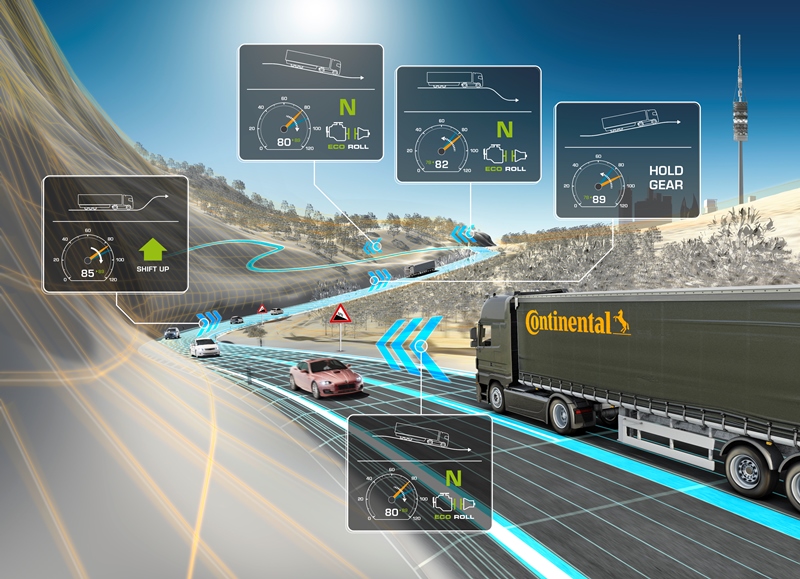When it comes to commercial vehicle efficiency, it is usually the engine, the weight and the aerodynamics that are taken as examples. But sensor systems can also play an important part in fuel-saving driving. A good example of this is the electronic horizon (eHorizon) from the automotive supplier Continental. Based on high-precision topographic trip data and a GPS signal, it supplies a three-dimensional profile of the route ahead to the Adaptive Cruise Control and other electronic control units in the vehicle. Together with software from the vehicle manufacturer which adapts the vehicle’s driving style to the road, the eHorizon thus helps reduce fuel consumption. In this year alone, MAN and a further major European truck maker have integrated the sensor system into their vehicles, several production launches in Europe and North America are being prepared for both the coming year.
MAN is offering a system comprising eHorizon and solutions of its own under the name Efficient Cruise. Tests verified by TÜV have shown that it achieves fuel savings of more than six percent. By Continental’s estimates, it has been possible to save more than 195 million litres of diesel fuel since 2012, when the technology went into series production. This corresponds to more than 260 million euros and more than 5,15,000 metric tons of carbon dioxide. In developing the sensor systems, Continental is cooperating with the location cloud developer HERE, which supplies the map material.
Considerable fuel savings possible, combined with enhanced safety and comfort
The electronic horizon continuously compares the position of the vehicle with high-precision topographical map material and passes information on the route ahead to other control units. These units automatically adapt the driving style and speed to the route ahead. For example, they accelerate the vehicle before an uphill stretch in order to gain the greatest benefit from the available torque and reduce gear changes to a minimum. Before a downward incline, the vehicle speed is reduced to take maximum advantage of the vehicle acceleration during the descent. That not only saves fuel and increases safety, but also ensures greater comfort, since hard braking can also be avoided in certain driving situations. According to Continental’s calculations, commercial vehicle fleets can reduce its fuel consumption by up to at least three percent thanks to the eHorizon and OEM-specific systems can contribute added improvements.
Real-time updates and information on dynamic events in further extensions
Continental is continuously developing this successful series product. In the next expansion stage, the connected eHorizon, the sensor system can save data recorded by the vehicle locally and transmit it to a cloud-based environment. Here, the data from all vehicles is collated and made available to all users at regular intervals for map updates. This allows detailed information to be incorporated into a digital map or newly created for routes where only patchy map data is available.
In the final expansion stage, the dynamic eHorizon, the digital map material is updated by interlinking it in real time to HERE’s location cloud. In addition, Continental intends to improve the maps with further information that is important for road users. Then the system will also warn the driver of suddenly occurring events such as poor weather, accidents or traffic jams.
“The electronic horizon thus becomes a high-precision and bang-up-to-date information carrier. This will not only improve driving comfort and driver safety, but also help commercial vehicle manufacturers to further reduce the total cost of ownership, which is a crucial factor for them,” says Dr. Michael Ruf, head of Continental’s Commercial Vehicles & Aftermarket Business Unit.
Moreover, the eHorizon can prepare driver assistance systems, brakes or steering for the upcoming traffic situation even before the vehicle sensors register the situation. If, for example, it reports the end of a tailback behind a bend, the speed of an automated vehicle can be gently reduced, instead of having to slam on the brakes when the sensors detect the obstacle. With the dynamic eHorizon, highly automated driving is more comfortable because the technology supplements the vehicle sensors and provides an additional information source.
Continental develops intelligent technologies for transporting people and their goods. As a reliable partner, the international automotive supplier, tyre manufacturer and industrial partner provides sustainable, safe, comfortable, individual and affordable solutions. In 2015, the corporation generated preliminary sales of approximately €39.2 billion with its five divisions, Chassis & Safety, Interior, Powertrain, Tyre, and ContiTech. Continental currently employs more than 2,08,000 people in 53 countries.
Information management in and beyond the vehicle is at the very heart of the Interior division. The product portfolio for different types of vehicles includes: instrument clusters, multifunctional and head-up displays, control units, access control and tyre-information systems, radios, infotainment systems, input devices, control panels, climate control units, software, cockpits as well as services and solutions for telematics and Intelligent Transportation Systems. The Interior division employs more than 36,000 people worldwide and generated sales of approximately €7 billion in 2014.
Within the Interior Division the Commercial Vehicles & Aftermarket Business Unit accommodates the specific requirements of the commercial vehicle, special vehicle and aftermarket sector. A global network of sales and service companies ensures proximity to local customers. Covering the product brands Continental, VDO, ATE, Galfer and Barum the Business Unit offers electronic products, systems and services for commercial and special vehicles, a broad selection of products for specialized workshops and spare parts for the Independent Aftermarket and the Original Equipment Services after end of series production of the vehicle manufacturer.
